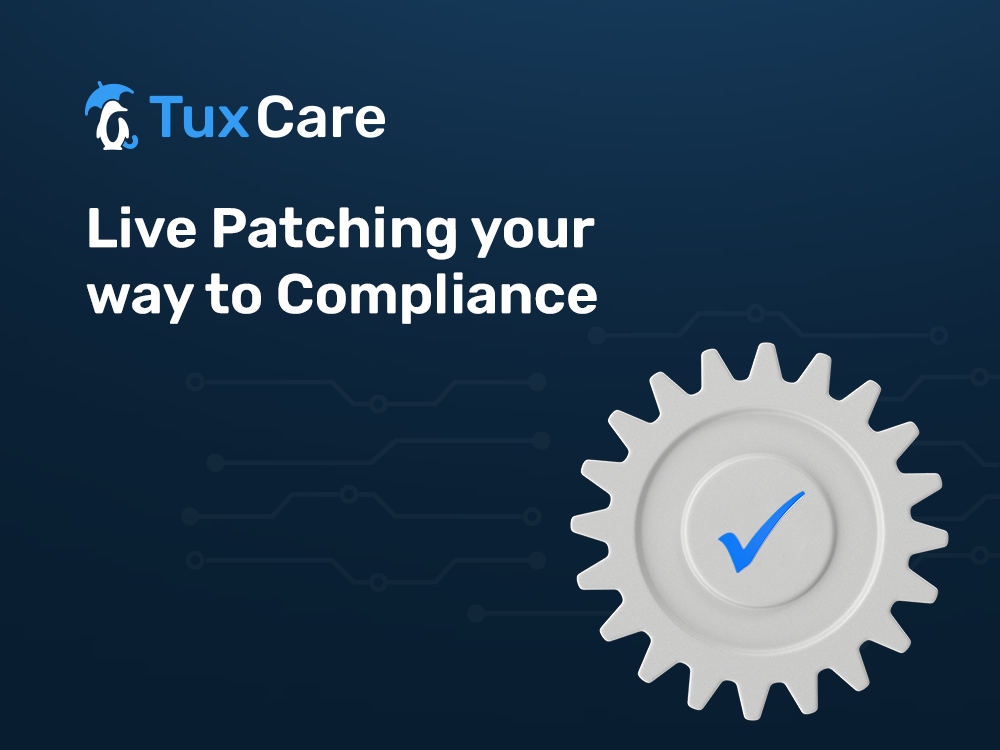Live Patching Your Way to Compliance
The National Institute of Standards and Technology (NIST) advised organizations, including healthcare, federal/state government, and financial services providers, to deploy software updates through enterprise patch management tools using a structured method to reduce the associated risks by applying them to all hosts and applications.
Organizations outside the federal government will often adopt the NIST 800-171 framework because of its broad compliance coverage and privacy mandates interwoven into the various controls defined within, including patch compliance and recommended automation workflows.
Live patching from TuxCare, which provides automated vulnerability patching without needing to reboot the Linux kernel, aligns with the NIST 800-171 framework by providing accelerated critical patches to Linux hosts and other components that enable organizations to stay up to date with the latest security vulnerabilities.
So, how does live patching help with each compliance regime, specifically?
Live Patching for FedRamp
The FedRamp standard procedure for procuring and delivering cloud services aims to provide the required security information for government departments and organizations conducting business with the federal government. FedRamp aligns with NIST 800-53 and all federal government departments are required to comply with this framework.
FedRamp compliance is rigorous and expensive; however, it opens up companies of every size to the growing cloud market. It is critical to achieving security targets by using an approved FedRamp CSP, including confidentiality and privacy; it relates to protecting personal information. Patch management compliance helps departments meet regulatory standards while reducing the impact of critical vulnerabilities affecting various attack surfaces.
Live patching solutions help government agencies comply with NIST 800-53 within two parts of FedRamp regulations: flaw remediation and malicious code protection. FedRamp compliance controls are applicable to cloud computing services only.
Unlike other patching approaches, live patching enables organizations to automatically apply the latest patches without needing to reboot systems – helping them stay on top of NIST 800-53 requirements with significantly less manual work and downtime involved.
Complying with CMMC Maintenance Domain
To be CMMC compliant, the organization must review and document activities to assess effectiveness, notify high-level management of any challenges, and ensure that processes are optimized throughout the organization.
The CMMC Maintenance domain (MD) publishes guidelines for prioritization, organizing, and executing maintenance:
- 2.111 Perform patching maintenance on systems mandated by compliance standards.
- 2.112 Provide controls on the tools, techniques, and personnel used to conduct system maintenance, including automation of patching management.
- 2.113 Require MFA to establish non-local maintenance sessions via external network connections.
- 2.114 Supervise the maintenance activities of personnel without required access.
With TuxCare’s live patching solutions for Linux hosts, OpenSSL, open-source databases, and other critical libraries assist clients in more easily meeting CMMC maintenance domain requirements. Along with patching critical systems, TuxCare supports the internal placement of their patch management console within an air-gap closed-looped network for secure deployment of updates.
Patching as Preventive Medicine for Healthcare IT
Healthcare organizations should continuously patch all systems to protect against any known vulnerabilities. Many healthcare organizations admit they’ve experienced a data breach because of unpatched vulnerabilities. Due to budget challenges in the healthcare market, many organizations lack a defined vulnerability management program with an enterprise-wide patch management process. As more healthcare providers move their applications to the cloud, the need for advanced vulnerability management is essential.
Managing HIPAA Compliance with Limited Resources
HIPAA doesn’t specifically address vulnerability management, but it covers identifying vulnerabilities.
Regulation 45 C.F.R. § 164.308 (a) (5) (ii) (B), as well as its evaluation standard at 45 C.F.R. § 164.308 (a) (8), covers patch management processes too.
Organizations schedule and perform a formal risk analysis to determine any potential breaches in electronic personal health information to align with confidentiality, integrity, and availability according to 45 C.F.R. § 164.308 (a) (1) (i) (A). Afterward, HIPAA-compliant risk management processes should be performed as stated in 45 C.F.R. § 164.308 (a) (1) (i) (B).
However, organizations need to identify and mitigate the risk posed by unpatched software. They should include an inventory of software as one component of their security attack mitigation plan. Maintaining an accurate patch compliance status reporting system will help healthcare organizations realize their risk to various systems and applications.
Live patching has been proven to be effective at rapidly securing healthcare systems by providing full automation of software vulnerability updates with no complex change control windows, fewer SecOps resources, and zero patching-related system reboots.
PCI 6.2 (Credit Card Processing) Patching to Protect Every Swipe
To comply with PCI DSS requirement 6.2, organizations that handle payment card data must install any available security updates on all relevant systems within one month of availability.
All patching activities should report an enterprise-wide log management system for security analytics and compliance reporting.
Why is Patching Critical to PCI Compliance?
- Attackers may exploit these vulnerabilities to attack or disrupt a system or gain unauthorized access to sensitive data.
- Organizations must prioritize PCI critical infrastructure systems and devices when applying security updates.
During monthly or annual audits, organizations processing credit cards on unpatched or vulnerable systems will be subject to fines and suspension from accepting credit cards until the security is resolved and re-audited.
Additional PCI compliance requirements; including DS6.4, require all secure applications and systems follow proper change management, including patching security updates and specific applications supporting credit card systems.
Credit card processing terminals running Linux operating systems can be patched more often and sooner after patches are available when organizations adopt a live patching approach.
Supporting PCI 6.4 Change Control
PCI DSS Requirement 6.4 includes procedures around change control processes for all changes to system components.
It also recommended patching for the following:
- Patches should apply to all dev, stage, and QA environments similar to live production systems.
Organizations should maintain a distance between the QA and development environments and production cardholder data. The space is required to prevent production cardholder data from becoming compromised through less secure configurations and potential weaknesses in QA or Dev platforms.
Meeting Compliance Mandates With TuxCare
Compliance mandates are critical for the continued operations of most regulated organizations. Companies conducting business in regulated markets that require their IT systems, applications, and cybersecurity protection to meet the various compliance mandates, including, FedRamp, CMMC, HIPAA, and PCI, can adopt a live patching approach to put their vulnerability patching on autopilot and comply with these regimes more easily.
Not only does TuxCare offer automated, no-reboot live patching for all popular enterprise Linux distributions, but TuxCare live patching solutions feature flawless interoperability with vulnerability scanners, security sensors, automation, and reporting tools.
Beyond enterprise Linux kernels, TuxCare deploys live patching to shared libraries, virtualization platforms, open-source databases, and IoT devices – as well as end-of-life Linux, like CentOS 7.
Ready to chat with a Linux patching expert to learn how adopting a live patching approach can improve your organization’s operational efficiency?



 Documentation
Documentation Login
Login



